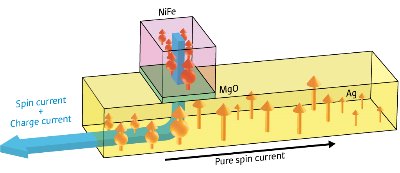Oct. 7, 2011 Research Highlight Physics / Astronomy
Moving forward, spin goes sideways
Improvements to specialized valves that separate spin and electron currents may lead to higher-density magnetic media
 Figure 1: In this lateral spin valve, a current is applied to a ferromagnetic nickel–iron contact (pink), in which spins are aligned in a particular direction. A thin layer of magnesium oxide (green) separates the contact from a non-magnetic silver wire (yellow). While both spin and charge current flow to the left (blue arrow), only spin current flows to the right (black arrow). © 2011 YoshiChika Otani
Figure 1: In this lateral spin valve, a current is applied to a ferromagnetic nickel–iron contact (pink), in which spins are aligned in a particular direction. A thin layer of magnesium oxide (green) separates the contact from a non-magnetic silver wire (yellow). While both spin and charge current flow to the left (blue arrow), only spin current flows to the right (black arrow). © 2011 YoshiChika Otani
Building electronic devices that work without needing to actually transport electrons is a goal of spintronics researchers, since this could lead to: reduced power consumption, lower levels of signal noise, faster operation, and denser information storage. However, the generation of pure spin currents remains a challenge. Now, YoshiChika Otani and colleagues at the RIKEN Advanced Science Institute, Wako, and five other research institutes in Japan and China, have produced a large spin current in an important spintronic device called a lateral spin valve1.
Spintronic devices store information in the spin of electrons, rather than in their density or energy level. Information flows through the propagating waves of spin orientation, while electrical charges remain stationary. Inside a lateral spin valve, a current of electron spins—but not of electron charges—is injected into a nonmagnetic wire through a ferromagnetic contact (Fig. 1). The current travels down the wire, and creates an output voltage across a second ferromagnetic contact, which serves as the output of the device. This lateral arrangement is important because it allows charge and spin currents to flow independently and permits the use of multiple terminals. However, while a practical lateral spin valve would require a large output voltage, previous devices had produced only 1 microvolt or less.
To increase the output voltage of their device, Otani and colleagues concentrated on the quality of the junction between the two ferromagnetic contacts and the non-magnetic, silver wire. Between the wire and the ferromagnets made of nickel and iron, the researchers placed a thin layer of magnesium oxide, which served to increase the efficiency of spin injection. They found that the straightforward annealing of their device at 400 °C in a mostly nitrogen environment reduced the quantity of oxygen in this interfacial layer.
This lowered junction resistance by a factor of up to 1,000, and increased the efficiency of spin injection into the silver wire. As a result, the output voltage reached 220 microvolts, which is more than 100 times greater than that of existing devices. In addition, the research team was able to observe the injected spins rotating, of what is technically known as precessing, in response to a magnetic field along the entire length of their 6-micrometer silver wire, confirming high spin injection efficiency.
The spin valve could be further improved, says Otani, by using cobalt–iron ferromagnets, which are known to have greater spin injection efficiency than nickel–iron, with potential near-term application as sensors in high-density magnetic media.
References
- 1. Fukuma, Y., Wang, L., Idzuchi, H., Takahashi, S., Maekawa, S. & Otani, Y. Giant enhancement of spin accumulation and long-distance spin precession in metallic lateral spin valves. Nature Materials 10, 527–531 (2011). doi: 10.1038/nmat3046
